Duck Confit Recipe
Looking for a super-simple duck confit recipe? You’ve come to the right place.
If you’re familiar with duck confit (pronounced con-FEET), you already know that it practically melts in your mouth, is loaded with flavor, and can elevate even the most urbane dishes to gourmet status.
But duck confit doesn’t just taste great – it can also be a health-promoting dish that is rich in belly-flattening, disease-fighting monounsaturated fats.
And because it is cooked “low and slow” and kept moist throughout the process, there is little concern for generating harmful cooking byproducts like lipid oxidation products (LOPs) and heterocyclic amines (HCAs) that can damage our DNA and cells.
And here’s the best part…
Despite its fancy reputation and legendary gourmet tradition, duck confit is very easy to make at home with just a few ingredients and minimal prep time. In fact, the hardest part about making duck confit is waiting until the dish is done.
Below, you’ll find a simple step-by-step recipe. But first, I want to share a little history on this treasure from the south of France and the culinary preservation method that’s making a comeback…
What is Duck Confit?
The word “confit” translates to “preserved” in French. It is an old-world technique, traditionally used for preserving duck, pork and goose.
But it is not the slow cooking that’s responsible for confit’s long shelf life – it’s the salt. Salt prevents the growth of microorganisms by drawing water out of microbial cells through osmosis. (You need a concentration of about 20% to kill most harmful species). The amount of fat covering the confit during storage also reduces spoilage, by preventing air from coming into contact with the meat.
Confit that is properly prepared will keep in the refrigerator for up to six months. But you’ll find so many ways to enjoy it, it’ll be gone much sooner than that!
Now that you know a little bit of the history, let’s get started with the easy preparation…
Duck Confit Recipe: The Easy Step-By-Step
The first (and most important step) is choosing the healthiest ingredients.
Most duck is factory-farmed, given routine antibiotics and growth hormones, crammed into tight, inhumane quarters and often force-fed to create fatty livers for foie gras production. For these reasons, we highly recommend that you avoid conventionally-raised duck.
We prefer using Pastured duck legs and duck fat from US Wellness Meats, sourced from free-range Pekin Ducks, fed a non-gmo diet, free of growth hormones and antibiotics.
The traditional method of preparing confit involves using pure duck fat to cook the legs. I like to make this delicacy a bit more affordable (and pack in more monounsaturated fats) by using a 50:50 blend of duck fat and avocado oil. You will still enjoy the rich flavor at about half the cost (I use Olivado for this recipe, but we also love Ava Jane’s unrefined avocado oil).
Once you have finished making your duck confit, you’ll have a nice supply of “duck-a-cado” oil that is safe to use at medium to high temperatures and is great for sautéing veggies, drizzling over roasted winter squash and root veggies, and of course, searing meats.
Onto the next key ingredient: salt. I use a combination of mineral-rich Real Salt and Smoked Maldon. I find this combination gives the confit a pleasant slightly “smoky” taste.
And finally, the aromatics… you’ll also need some bay leaves, thyme and black peppercorns.
Here’s a photo of everything you’ll need for your duck confit:
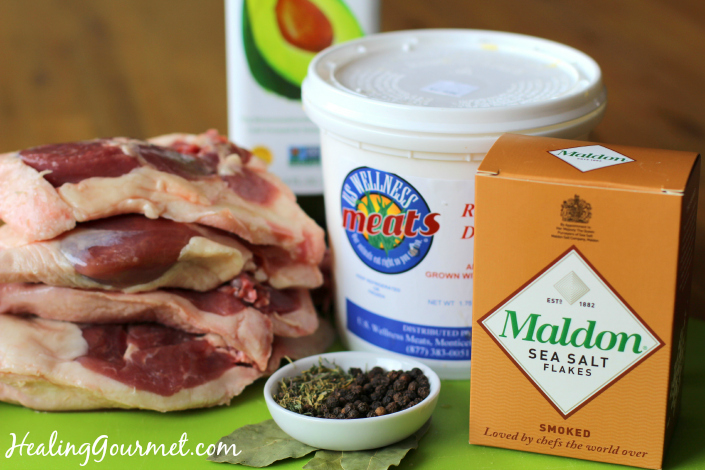
… and here’s what it will look like when its done…
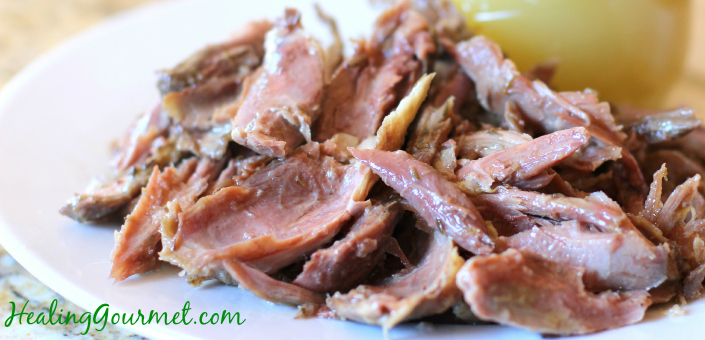
Original
Prep Time
10 mins
Cook Time
6 h
Total Time
30 h
Servings
6
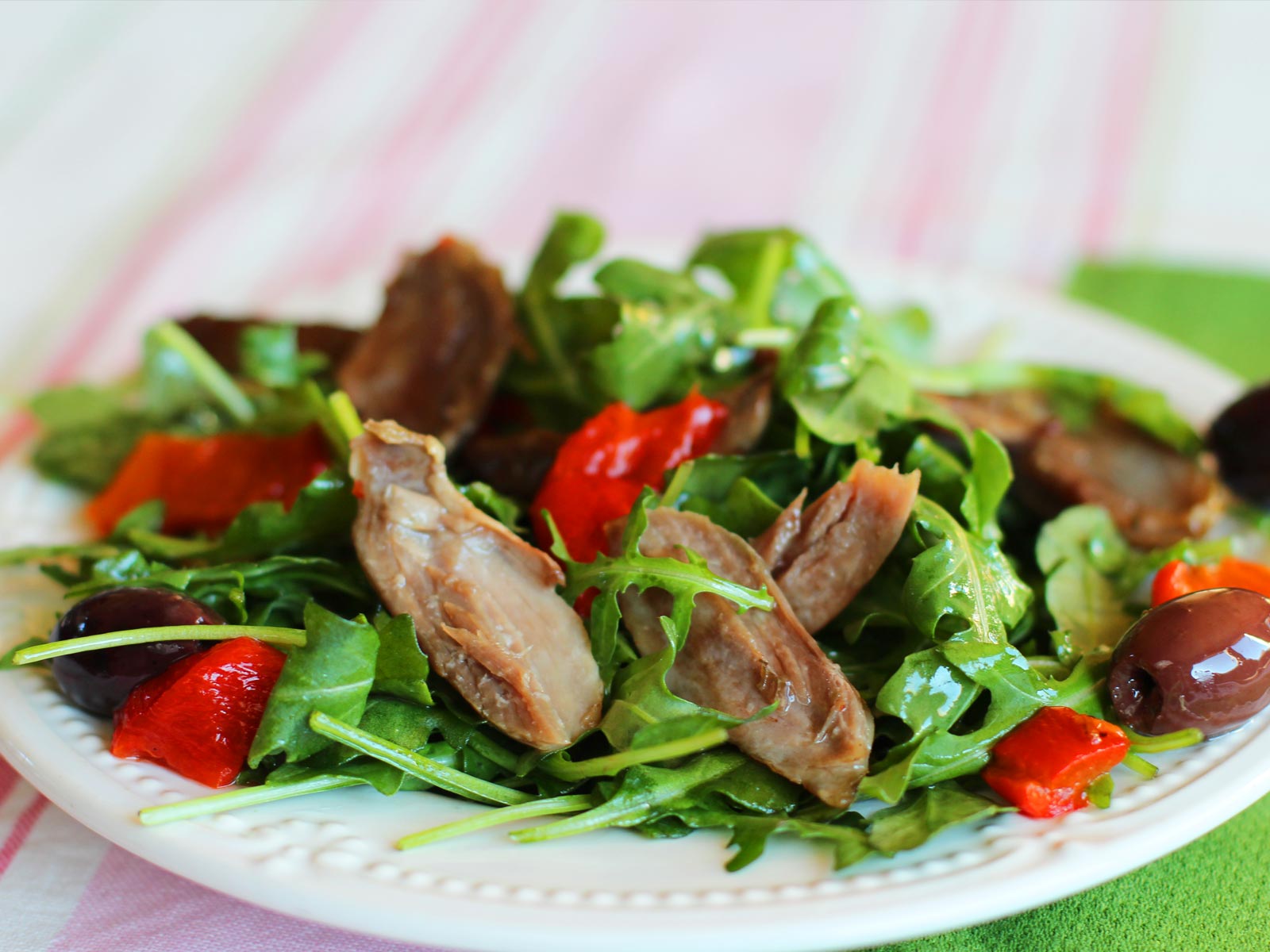
Ingredients
- 6 free range duck legs (about 3 lbs.)
- 2 cups free range duck fat
- 2 cups avocado oil
- 6 sprigs fresh thyme, stripped
- 3 bay leaves, crushed
- 1 Tbsp. peppercorns, crushed
- 1/4 cup salt (Real Salt and/or Smoked Maldon, preferred)
Instructions
- First, rinse the duck legs and then pat dry. Combine the salts and aromatics. Add the duck legs to a large zip-top bag and pour in the salt mixture. Rub the legs to coat.
- Transfer to the refrigerator to cure for 24-36 hours.
- Remove duck legs from curing in the refrigerator. Rinse and pat dry. Then add the legs to a slow cooker or slow-cooker / pressure cooker hybrid. I use the Instant Pot for its versatility and safe, stainless steel interior.
- Now, melt the duck fat and add the avocado oil. Add the melted oil to the duck legs until they are completely covered. Turn on the slow-cook function and cook for six hours on low.
- Let the vessel cool slightly, then separate duck meat from oil and pull or chop the meat into small chunks. Now, you can now put your duck confit into mason jars and use a safe canning method for long term storage. Or simply pack the meat in jars and then cover completely with the fat. This will remain good in the refrigerator for up to several months, but it’s probably best to enjoy it within a few weeks.
Nutrition & Macronutrient Ratio
Nutrition Information Per Serving
278 calories, 16 g fat, 4 g saturated fat, 8 g monounsaturated fat, 3 g polyunsaturated fat, 133 mg cholesterol, 1 g carbohydrate, 1 g NET carbs, 0 g sugar alcohols, 0 g sugar, 0.1 g fiber, 30 g protein, 10 mg potassium, 3 mg phosphorous, 997 mg sodium, 1 mg magnesium
54 % FAT | 45 % PROTEIN | 1% CARBOHYDRATE
How to Enjoy Your Duck Confit Recipe
There are unlimited ways to enjoy this gourmet treat. I especially enjoy melting duck confit until it is warm and then pouring the meat and fat mixture over a fresh salad. I also like to serve it as a starter at dinner parties, where it has always been a hit.
But one thing is for sure, once you taste that first bite, I think you’ll agree that this is one dish that you will want to enjoy this duck confit recipe over and over again.
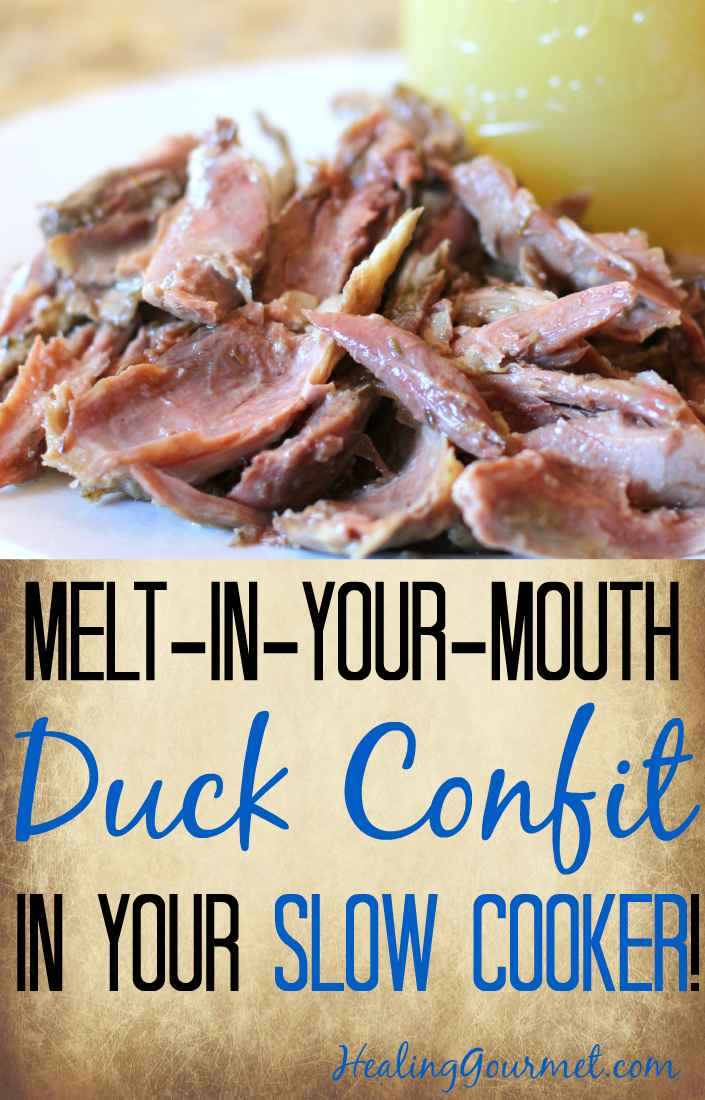
Have you ever made duck confit? If so, what ingredients and preparation did you use and how did it turn out?
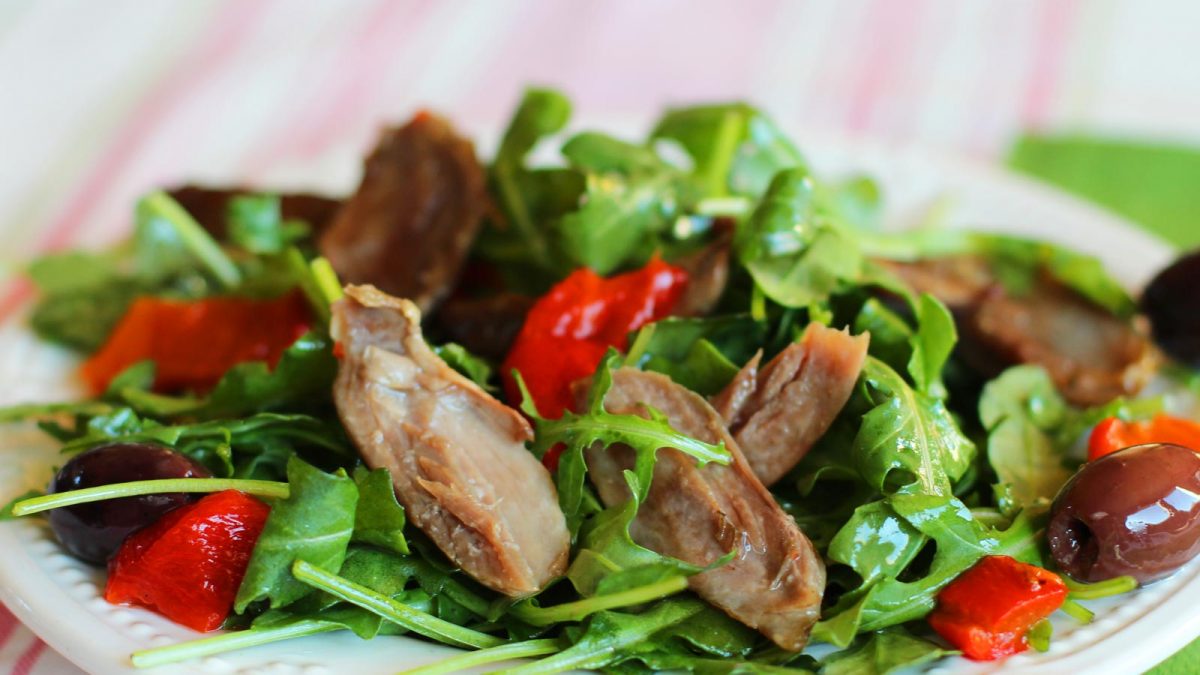


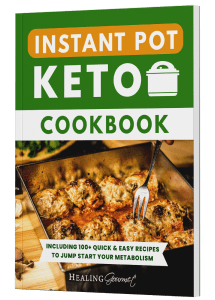
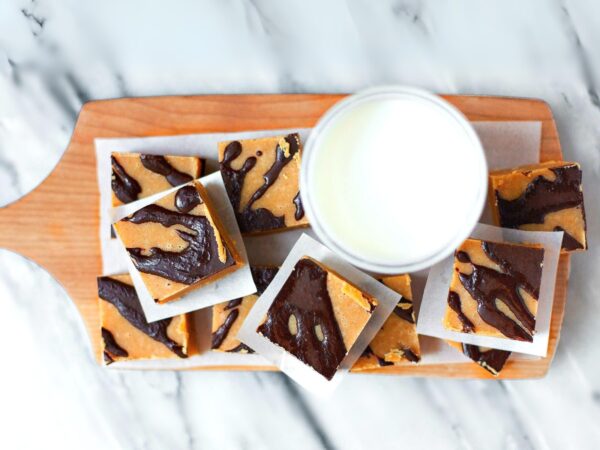
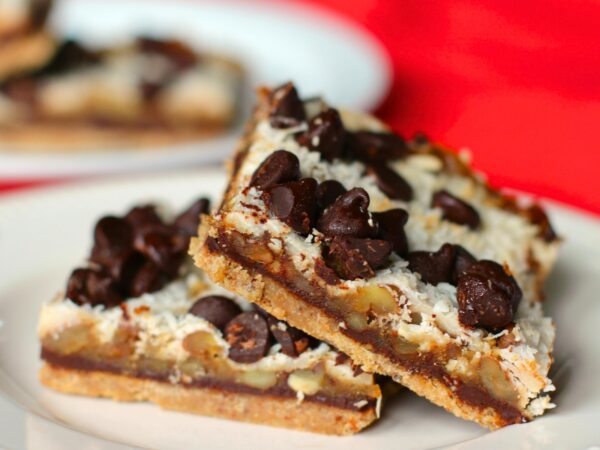

I can’t find the Nutrient Information for Duck Confit on your website, though it says you have it.
People with Diabetes must be aware of their carbohydrate intake.
If you think your recipes are healthy (and I have purchased several books and products from you already) why hide the nutritional information? Everything should be on the up and up and hiding nutritional values makes me wonder.
Hi Jean,
I would say thank you for the comment, but I don’t really feel that way with the oddly accusatory remarks and skepticism about the validity of our information.
There is a simple reason this recipe doesn’t have any nutrition information. When you add 4 cups of fat to a dish with 6 servings, but you consume only a miniscule amount of that, how do you account for the 3.75 cups that are not consumed in the servings, and instead consumed later in other recipes? I thought of modifying the recipe in our proprietary nutrition system (which even calculates to the mcg of micronutrients like lycopene), but it would not be completely accurate as I have not weighed the total amount of starting ingredients compared with the weight of the cooked ingredients to determine the amount of fat that is actually absorbed into the duck lugs during the cooking process. I would rather not post any nutrition information, than post “guestimate” nutrition information, which I feel is the right way, or on the “up and up”, as you say.
Lastly, being a diabetic, I’m sure that you know which foods have carbohydrates. Duck legs, salt, avocado oil, duck fat, peppercorns, bay leaves and thyme have exactly none.
Kelley
LOL, Jean. You’ve clearly never had duck confit. It’s all fat and meat and fat. Did I say fat? No carbs. I suggest to try it first from a can. The French make a really great canned confit, which you can buy on Amazon. And it’s got a nutritional label! However, Kelly is right. You don’t usually eat a lot of duck confit. Think of it as similar to a “pork belly,” but stewed in its own fat. I usually add duck confit as an ingredient in a French cassoulet (bean stew). Or I eat a small portion with a lot of side dishes. Anyway, here is the amazon link with nutritional label: https://www.amazon.com/Rougie-Confit-Duck-Legs-52-91oz/dp/B0008JGWB4/ref=sr_1_1_a_it?ie=UTF8&qid=1499350360&sr=8-1&keywords=duck%2Bconfit&th=1. Kelly’s recipe is better and healthier with the avocado oil.
This recipe has my mouth watering and I can’t wait to try it. I ordered my duck legs from US Wellness Meats this afternoon, but unfortunately they are out of stock on Duck Fat! 🙁
I have signed up to be notified when it is back in stock but the duck legs are on the way and I would like to make this as soon as it comes if I can figure out what else I can do.
Do you know of an alternative source for good quality duck fat? Is it possible to use only avocado oil for the whole recipe? Perhaps I could buy an extra duck and render my own? I think I might have some duck fat leftover from Christmas in my freezer. I have plenty of chicken fat – would that work? Just trying to figure out how to do this without the wonderful duck fat @ US Wellness Meats!
Any suggestions?
Hi Linda!
Thanks so much for your kind comment and question. I have a couple of ideas for you…
First, you can render a good bit of duck fat from duck breasts or whole duck. I am amazed at how much you can get. Start with a cold pan, preferably ceramic/enameled cast iron and place in pan skin side down (score the skin to avoid curling) and heat over very low heat – the fat will melt off and you can reserve. Here is more on that – https://healinggourmet.com/cooking-with-duck-fat/
Next on the alternate fats. Chicken fats are not advisable. It is very high in omega 6 fat making it an unhealthy option. However, I have made confit with all avocado oil (a monounsaturated fat) and it turned out great. You don’t get so much of the duck-y flavor, but still delicious and packed with those healthy fats.
I know it is frustrating when US Wellness Meats is out of one of the ingredients you need, but in this case, it is worth the wait. You can put your name on a notification list when it is back in stock for your next batch of confit.
Hope this helps!
Be Well,
Kelley
Thanks Kelly, I didn’t know about chicken fat being harmful! I need to go through your site and read every single thing that you have written!!!
After doing a long, arduous web search I have come to the conclusion that PASTURED duck fat is as scarce as “duck’s teeth”! There is none to be had as far as I can tell. But I DID find a source for ALL NATURAL duck fat. It is a fairly large quantity – 7.5 lbs and I’m not sure I want to invest a lot of money for a large quantity of something that isn’t exactly what I am looking for.
Do you think a duck fat labeled ALL NATURAL is worth buying or would you wait for the pastured kind to come available again?
Thanks!
~Linda~
Hi Linda,
You’re right about healthy duck fat being scarce – US Wellness Meats is the only kind I have found. “All Natural” unfortunately doesn’t mean much. Ducks that are “all-natural” can be fed GMO feed, cramped in pens and administered antibiotics, etc. I would wait for pastured or do a trial run with avocado oil if you really have a confit craving 🙂
Be Well,
Kelley
Hi again Kelley!
So, since reading this article and your other ones on duck fat and coconut oil, I’ve been paying far closer attention to the kinds of fats I use. I wanted to know your thoughts on Turkey Fat? Right after the holiday season last January, I was able to get a heritage turkey from my local health food store at a deeply discounted price. It has been in my deep freeze til now, and yesterday, I thawed it out and roasted it. Now I have a large amount of lovely Turkey Meat, two gallons of Turkey Bone Stock, and a second boiling of the bones to add to my dog food. This turkey also yielded a pint of Turkey Fat and I’m trying to decide if this is a “good” fat, (like duck) or a “bad” fat (like chicken).
What is your opinion? Should I strain it and use this turkey fat in cooking or should I discard it?
Thanks! 🙂
~Linda~
Oh – one other question.
I don’t like to use plastic for marinading or curing. I am thinking that you are calling for a zip-lock bag for the curing because it holds the salt and the meat close together. I do that sometimes with a fish marinade that I like and the plastic bags are great for that. However I worry about leaching.
Do you think mixing the ingredients in a glass container for curing would work as well? Or should I go ahead and use the zip-locks and not worry about the plastic? I am concerned that the open space of a glass container might cause everything to spread out and not cure correctly.
Thanks! 🙂
I’m with you on this, Linda. I really don’t like using plastic for anything.
I marinate in a large shallow glass dish that allows everything to be in a single layer – I think that will work just fine for this recipe.
Hi, Ms Kelly. I just want to let you know that I am enjoying the recipes in your last book and recipes from this website too. I would like to ask you if you know what is the best skillet to cook pancakes. I will appreciate. Thanks
Thank you for this recipe! I recently had Duck Confit at a restaurant and it was amazing! I cannot wait to make your recipe.
I have no idea where to find duck legs and duck fat? Whole Foods?
Are all ducks raised free-range or are there factory farms for ducks, like for chickens?
Hi Sheri… yes, unfortunately, ducks are often raised in conditions that are similar to other factory farmed animals. We purchase pastured duck legs and duck fat from US Wellness Meats. There is a link in the post above to their website. Here is that link again. Of course, there are many other suppliers as well. That would include some in your own area, I would assume. Eat Wild has an excellent director of local farms that raise their animals naturally and humanely. Here is that link also: http://www.eatwild.com/products/index.html
Kelly: I was interested in knowing if you can make the confit from duck breast. I found some duck breast and wanted to try it with the avocado oil. Or can you only do it with legs?
Hi Debbie,
Thank you for your question.
While I think dark meat – legs and thighs – are better suited for confit, everything I have read says that breast meat can absolutely be made into confit.
If you give it a go, please let us know how it turns out!
Be Well,
Kelley
Hi Kelley,
Do you have to slow cook this for 6 hours in the Instant Pot or can you use normal to high pressure and cook for a shorter amount of time?
After much hesitating, I finally got the courage to buy a whole duck. Can’t wait to try this! I just rendered duck fat (2nd method, with water) and the cracklings were to die for!
Hi Dee,
Duck cracklings are amazing!
For your question: Because making confit requires fat for cooking (not water), there risks. Many users guides state to use no more than 1/4 cup oil.
In a quick search, I found a couple interesting posts on the topic – http://missvickie.com/howto/fry/frying.html and http://www.eatdrinkexperience.com/duck-confit-and-waffles-under-2-hrs-start-to-finnish/. While the latter example eliminates the risk of oil, they are wrapping the duck in plastic and foil and then pressure cooking. Perhaps it is tasty, but it is also a great way to super-infuse the duck with plastics. Often the quick way is not always the best way 🙂
Be Well,
Kelley
Sounds great recipe with duck to me checking the ingredients show nutritional value. All grains especially WHEAT i’ve read should be avoided if you have any autio immune disease including diabetes .
Hi Bev,
I agree with you – wheat is a very detrimental food for people with autoimmune issues.
I hope you enjoy the duck confit!
Be Well,
Kelley
We just finished dinner and the recipe was so delicious! Thank you for sharing! 🙂
You mentioned to save the duck oil to use for future cooking purposes. Could the left over duck-a-cado be used for another batch of confit and turn out just as good the second time?
Hi Janine,
I’m so happy to hear you enjoyed the duck confit!
I always save my duck-a-cado oil in a mason jar and keep refrigerated for future confit batches and everyday cooking. It is also great for sautéing veggies (green beans, onions, broccoli) or using to roast root veggies like sweet potatoes.
Be Well,
Kelley
Thanks Kelley! We are getting ready to make another delicious batch this weekend! I’m going to have to check out your other recipes too. So glad I found your site. 🙂
Thanks, Janine! So happy to hear you enjoyed the confit and that you have returned to visit us! 🙂
This recipe has become a go to for us! We love it!! I was going to cook it for dinner today but forgot to start my recipe earlier. I’m wondering if this recipe can be done with the pressure cooking setting of the instant pot so it can be done in a shorter time?
Would I be able to use duck breasts ( wild) in place of the legs and if so do I need to adjust the amounts of fat nd oil used?
What’s gonna happen if I let it cure in salt longer …. I’m trying with a full duck ????
Is 3days too long?
This is my first year raising my own Muscovies and I will try this recipe when mine are processed. Can you use pork fat – either bacon or from ham roast, in addition to duck fat? I realize pork fat is not as healthy but we also raise our own berkshire pork and I like to use what I raise.
Can I also recommend that instead of buying duck from an online retailer, try your local farms? Buying local helps build demand for small scale, sustainable, healthy and ethical farming. Buying online still fosters large scale farm operations, and even ‘free range’ can be done on a factory scale an in conditions that you would not want to support. Support your local small scale farmers, and when possible, raise your own! Try local buy and sell sites, Facebook and farm markets to source your meats. Ask if you don’t see it as demand will increase supply if the farmer knows it will sell.
Hi Adriana!
You raise Berkshire pork and Muscovy duck? Can I come over for dinner? 🙂
You can certainly use pork fat in this recipe. And I think you might be surprised at the health benefits of lard. Most people don’t realize it is primarily a monounsaturated fat, like olive oil.
And I absolutely agree with you to buy local whenever possible, and to get to know your farmer. Of course, for many people living in cities this is not possible (nor is raising your own!).
Be Well,
Kelley